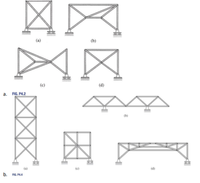
Structural Analysis
6th Edition
ISBN: 9781337630931
Author: KASSIMALI, Aslam.
Publisher: Cengage,
expand_more
expand_more
format_list_bulleted
Question
Classify the following trusses as stable or unstable. If stable determine if it is determinate or indeterminate. If indeterminate specify the degree of indeterminacy.

Transcribed Image Text:### Truss Structures Analysis
In structural engineering, trusses are designed to support loads efficiently. The diagrams below illustrate various truss configurations often used in construction.
#### FIG. P4.2
This section showcases truss frame configurations:
- **(a)**: A rectangular frame with diagonal members forming an 'X.' This design provides stability and resistance against lateral forces, common in bridges and towers.
- **(b)**: A trapezoidal frame with a diagonal member connecting non-adjacent corners. This layout enhances bending resistance.
- **(c)**: An inverted triangular frame with intersecting diagonal members forming a double 'X.' This geometry increases rigidity and distributes weight effectively.
- **(d)**: A rectangular frame with a single pair of intersecting diagonal members, forming an 'X.' Similar to (a), it is used to enhance lateral stability.
#### FIG. P4.4
This section presents linear truss configurations:
- **(a)**: A vertical truss with four faces arranged in a square configuration, typically used in communication towers for vertical stability.
- **(b)**: A simple triangular truss system, ideal for creating lightweight roof structures. The truss is typical in lightweight bridge decks and roof supports.
- **(c)**: A square vertical truss without diagonal members. This design is simpler and less rigid than those with intersecting diagonals, typically used in light-load scenarios.
- **(d)**: A larger rectangular truss with parallel top and bottom chords, supported by diagonal and vertical members. Suitable for longer spans, distributing loads efficiently.
Understanding these designs helps engineers and architects decide the appropriate type for specific applications, balancing material use against load-bearing requirements.
Expert Solution
This question has been solved!
Explore an expertly crafted, step-by-step solution for a thorough understanding of key concepts.
Step by stepSolved in 4 steps with 3 images

Knowledge Booster
Similar questions
- The truss structure shown below is subjected to the following loads F1= 437 lb F2= 726 lb and has the following geometry: w = 10 ft F2 F1 F1 W W -B D G. F -AC E Determine the support reactions at A and E. Determine the forces in members BC, CG, and FG and state whether they are in tension or compression. Determine the forces in members ED and EF and state whether they are in tension or compression.arrow_forwardThe truss ABC is constructed of three titanium (E Ti =17.4×10 3 ksi) members. A horizontal force of 1.8 kip and an unknown force P are applied to the truss at point B as shown. Member AB has a cross-sectional area of 0.1in 2 , member BC has a cross-sectional area of 0.0025ft 2 , and member AC has a cross-sectional area of 0.2 in2. b) Determine the magnitude of the force P that is required to displace the roller at point C to the right by .03 inches.arrow_forwardClassify each of the plane trusses shown as unstable, statically determinate, or statically indeterminate. If the truss is statically indeterminate, then determine the degree of staticac indeterminacy.arrow_forward
Recommended textbooks for you

 Structural Analysis (10th Edition)Civil EngineeringISBN:9780134610672Author:Russell C. HibbelerPublisher:PEARSON
Structural Analysis (10th Edition)Civil EngineeringISBN:9780134610672Author:Russell C. HibbelerPublisher:PEARSON Principles of Foundation Engineering (MindTap Cou...Civil EngineeringISBN:9781337705028Author:Braja M. Das, Nagaratnam SivakuganPublisher:Cengage Learning
Principles of Foundation Engineering (MindTap Cou...Civil EngineeringISBN:9781337705028Author:Braja M. Das, Nagaratnam SivakuganPublisher:Cengage Learning Fundamentals of Structural AnalysisCivil EngineeringISBN:9780073398006Author:Kenneth M. Leet Emeritus, Chia-Ming Uang, Joel LanningPublisher:McGraw-Hill Education
Fundamentals of Structural AnalysisCivil EngineeringISBN:9780073398006Author:Kenneth M. Leet Emeritus, Chia-Ming Uang, Joel LanningPublisher:McGraw-Hill Education
 Traffic and Highway EngineeringCivil EngineeringISBN:9781305156241Author:Garber, Nicholas J.Publisher:Cengage Learning
Traffic and Highway EngineeringCivil EngineeringISBN:9781305156241Author:Garber, Nicholas J.Publisher:Cengage Learning


Structural Analysis (10th Edition)
Civil Engineering
ISBN:9780134610672
Author:Russell C. Hibbeler
Publisher:PEARSON

Principles of Foundation Engineering (MindTap Cou...
Civil Engineering
ISBN:9781337705028
Author:Braja M. Das, Nagaratnam Sivakugan
Publisher:Cengage Learning

Fundamentals of Structural Analysis
Civil Engineering
ISBN:9780073398006
Author:Kenneth M. Leet Emeritus, Chia-Ming Uang, Joel Lanning
Publisher:McGraw-Hill Education


Traffic and Highway Engineering
Civil Engineering
ISBN:9781305156241
Author:Garber, Nicholas J.
Publisher:Cengage Learning